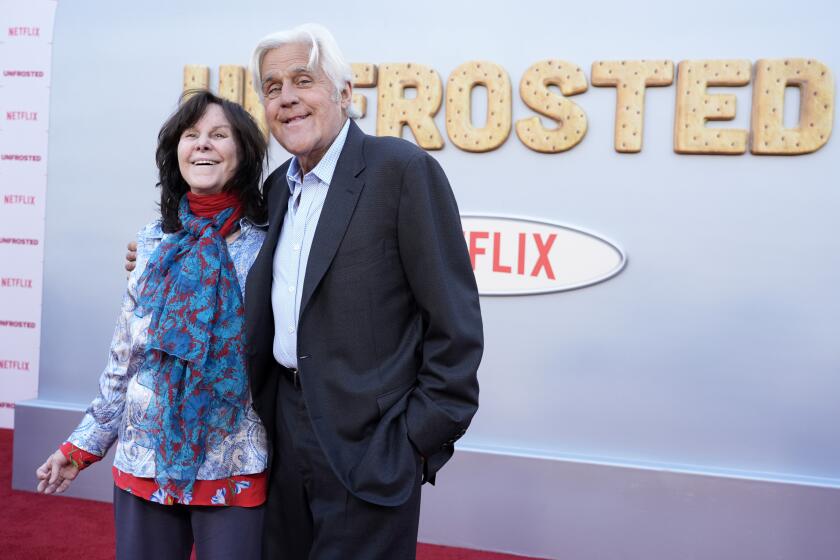Items of Interest in the ‘Pop Art Store’
- Share via
In 1973, while rummaging through a secondhand store in a small shopping center in suburban Toledo, Ohio, I came across an unexpected find. In a bin filled mostly with calendar-art type posters was a big, blunt picture of a cow’s head, printed in shocking pink against a banana-yellow background.
I asked the store’s proprietor where he’d gotten the cow and he grumpily allowed that he couldn’t recall. But, he also said it had been kicking around in that bin for a couple years, and couldn’t I please take it off his hands?
Great, I thought. An actual piece of Andy Warhol’s “Cow Wallpaper” (1966) had, in the space of just a few years, filtered its way through the voracious commercial marketplace and traveled from the tony art galleries of Manhattan to the secondhand racks of the American Midwest.
I recalled that chance encounter the other day, as I was rummaging through the galleries of the University Art Museum at Cal State Long Beach. There, director Constance Glenn has organized a timely and refreshingly lively survey show called “The Great American Pop Art Store: Multiples of the Sixties.” In addition to an entry wall jauntily papered over in Warhol’s “Cow Wallpaper”--not to mention its prototype collage, in which the banana-yellow background is instead an almost fluorescent orange--the exhibition gathers together a variety of goods in which artists sought to set aside the one-of-a-kind preciousness of traditional painting and sculpture and approach mass production in their work.
In addition to Warhol’s wallpaper, there are paper plates and ceramic dinnerware designed by Roy Lichtenstein, picture books by Edward Ruscha, souvenir pieces of plaster wedding cake by Claes Oldenburg, as well as jewelry, political buttons, business cards, decorated shopping bags and a handkerchief wittily adorned with a picture of a nose.
The center gallery features eight 7-foot-tall banners designed by artists (Jim Dine, Ernest Trova, Tom Wesselmann, Robert Indiana, Lichtenstein and Warhol). They were fabricated in editions, mostly in brightly colored felt applique, by the Betsy Ross Flag and Banner Co.
*
These and other hybrid objects in the show soon came to be called multiples, in order to distinguish them from one-of-a-kind paintings and sculptures or typical prints. In a sense, they represent an intersection between old and new.
The invention of multiples coincided with the nascent flourishing of a market for prints, which have always offered a lower-cost alternative to higher-priced paintings and sculptures. Traditional printmaking, in which unique works of art are multiplied in large editions, collided with the dream of mass-produced consumer goods designed by artists, prominent in the Age of Pop. Multiples were probably inevitable.
In sheer numbers, Roy Lichtenstein seems to have been the busiest artist in the field of ‘60s multiples. The show includes 16 items by him.
In addition to the paper and ceramic dishes, there are two enameled pendants, an intricately woven tapestry, a hat, deco wallpaper and gift wrap, two editioned sculptures and more (drawings and studies for several of these are also on view). The next most prolific artist was Warhol.
One curious feature of the show is the evident relationship that emerges between multiples and the homely world of domestic life. In the years that Rothkos and Pollocks were moving rapidly into museum collections, Lichtensteins and Warhols were moving into living rooms and dens.
Rugs, jewelry, wallpaper, coffee table knickknacks and such are works of art associated with a private domestic world. And that world--traditionally associated with women--is distinct from the public world of “serious” art, hitherto claimed as a masculine prerogative by Abstract Expressionist artists.
A similar shift can also be detected in the iconography of the art. Warhol’s pretty pink cow recalls the famous Borden’s trademark, Elsie. She’s a hilarious feminine rejoinder to what was reputed to be the greatest art of the 20th century: the work of the Spanish master Picasso, in which macho images of bulls and minotaurs (a man with the head of a bull) are ubiquitous.
It’s worth wondering too whether this conflict between masculine and feminine also extends to the very idea of commerce in art, which even today is regularly attacked as a degeneration of artistic values. Tellingly, the headwaters of that assault can be traced to the early 1970s, in the wake of the Pop upheaval.
Could it be that the feminine association of shopping--a leisure activity primarily targeted to women--is an agent of the now-standard hostility toward commerce as a legitimate consideration for art? Is the art world’s standard anti-consumerist rant merely unacknowledged sexism in action?
Interestingly, multiples have now accrued the patina of age. At Cal State Long Beach these once daringly new forays into the world of Pop ephemera now seem, from a distance of 30 years, charmingly old-fashioned.
Part of the reason is simply that many (though not all) of the works on view were indeed intended to be ephemeral. Who knew they’d still be around today--scarce items with collectible value?
Paper plates, gift wrap and tabletop knickknacks weren’t conceived to be precious objects, like paintings or sculptures; so, as with any commercially manufactured goods, they got banged up in the day-to-day passage of ordinary life. Seen today in a museum setting, protected under glass, these emblems of the New and the Now have acquired an unanticipated glow of the Old and Revered.
Multiples are now the stuff of the museum. So it’s not surprising that the show, which comes with a thorough and informative catalog, will embark on an extensive national tour after closing in Long Beach in late October. The last of its 10 stops will be the Toledo Museum of Art, in the summer of 2000.
Ah, the triumphant return of Elsie to Toledo! I wonder if that secondhand store proprietor still lives in town. And I wonder if he’ll stop by his local museum and suddenly remember that tatty poster, which lingered so long in his bin.
* University Art Museum, Cal State Long Beach, 1250 Bellflower Blvd., (562) 985-5761, through Oct. 26. Closed Mondays.
More to Read
The biggest entertainment stories
Get our big stories about Hollywood, film, television, music, arts, culture and more right in your inbox as soon as they publish.
You may occasionally receive promotional content from the Los Angeles Times.











